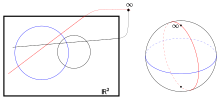Flat circular geometries
Flat circular geometries or Benz planes is a collective term for the three geometries described here: Möbius plane , Laguerre plane and Minkowski plane . Basic work comes from the German mathematician Walter Benz .
Möbius level
We start from the real Euclidean plane and combine the set of straight lines and the set of circles to form a block set. This construction provides a very inhomogeneous incidence structure . Because exactly one straight line and any number of circles go through every two points. The trick with which one embeds this incidence structure in a homogeneous geometry is the following idea: one adds another point to the set of points , which should be incised with each line. Now a block is clearly defined by exactly three points. This "homogenized" geometry is called the classic Möbius plane (after August Ferdinand Möbius ). The still existing inhomogeneity of the description (straight lines, circles) can be eliminated by a spatial model. Because by means of a stereographic projection one shows that the classic Möbius plane is isomorphic to the geometry of the plane cuts (circles) of a sphere (in 3-dimensional space). Analogous to the axiomatic projective planes, an incidence structure is called which has essentially the same incidence behavior as the classic Möbius plane, (axiomatic) Möbius plane . As expected, there are many Möbius levels that differ from the classic model.
Laguerre plain
If you start from again and first take the curves of the shape (parabolas and straight lines) as blocks, the following homogenization proves to be useful: You add the new point to the curve , i.e. H. the point set now consists of . This geometry of the parabolas is called the classical Laguerre plane (after Edmond Laguerre ). (It was originally formulated as the geometry of the directed straight lines and circles. Both geometries are isomorphic to one another.) As with the classic Möbius plane, there is also a spatial model here: the classic Laguerre plane is perpendicular to the geometry of the plane sections Circular cylinder (im ) isomorphic. An abstraction like the Möbius level leads to the (axiomatic) Laguerre level .
Minkowski level
If one finally proceeds from and adds the hyperbolae as blocks to the straight line , the following idea leads to a homogeneous incidence structure: Add the point to each straight line and the points to each hyperbola , i.e. H. the set of points in this case consists of . This geometry of the hyperbolas is called the classic Minkowski plane (after Hermann Minkowski ). As with the classic Möbius and Laguerre planes, there is also a spatial model here: the classic Minkowski plane is isomorphic to the geometry of the plane sections on a single-shell hyperboloid (non-degenerate quadric of index 2) in 3-dimensional real projective space. As with the Möbius and Laguerre levels, abstraction leads to the (axiomatic) Minkowski level .
Flat circular geometries
Since the blocks in each of the three cases are projective circles (not degenerate conic sections), the collective term flat circular geometries is used . The word is intended to indicate that there are also higher-dimensional Möbius, Laguerre and Minkowski geometries. The flat circular geometries are also in English literature Benz levels ( Benz plan ) after the German mathematician Walter Benz called.
See also
Individual evidence
- ^ W. Benz, Lectures on the Geometry of Algebras , Springer (1973) ISBN 3-540-05786-2
- ^ F. Buekenhout (ed.), Handbook of Incidence Geometry , Elsevier (1995) ISBN 0-444-88355-X , p. 1327














